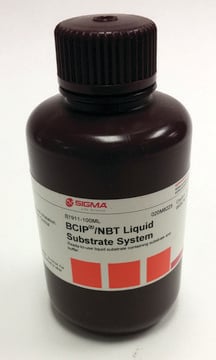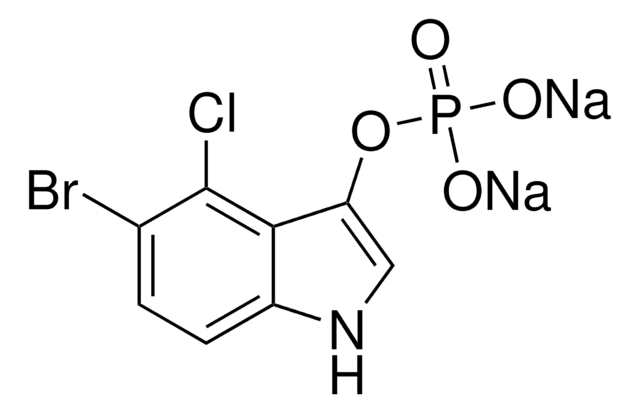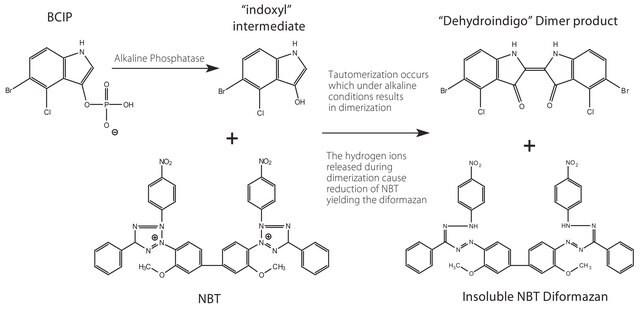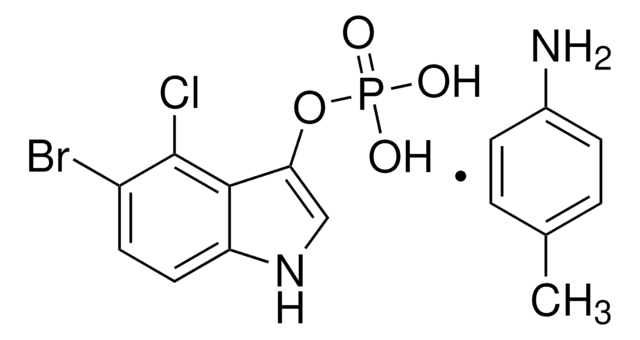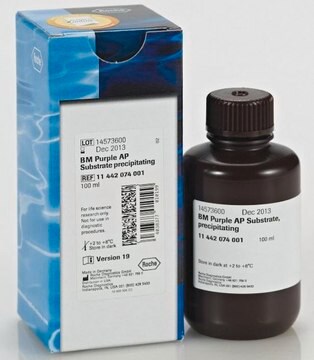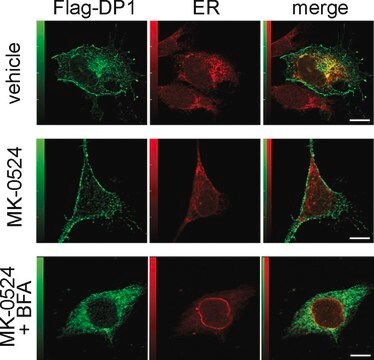72091
NBT-BCIP® solution
BioReagent, suitable as substrate for alkaline phosphatase in dot blots
Synonyme(s) :
BCIP®/NBT, NBT-X-phosphate
About This Item
Produits recommandés
Qualité
suitable as substrate for alkaline phosphatase in dot blots
Niveau de qualité
Gamme de produits
BioReagent
Forme
liquid
Solubilité
0.1 M Tris-HCl, pH 7.4: 0.0175 mL/mL, clear
Application(s)
diagnostic assay manufacturing
hematology
histology
Température de stockage
2-8°C
Chaîne SMILES
[Cl-].[Cl-].Cc1ccc(N)cc1.OP(O)(=O)Oc2c[nH]c3ccc(Br)c(Cl)c23.COc4cc(ccc4-[n+]5nc(nn5-c6ccc(cc6)[N+]([O-])=O)-c7ccccc7)-c8ccc(c(OC)c8)-[n+]9nc(nn9-c%10ccc(cc%10)[N+]([O-])=O)-c%11ccccc%11
InChI
1S/C40H30N10O6.C8H6BrClNO4P.C7H9N.2ClH/c1-55-37-25-29(13-23-35(37)47-43-39(27-9-5-3-6-10-27)41-45(47)31-15-19-33(20-16-31)49(51)52)30-14-24-36(38(26-30)56-2)48-44-40(28-11-7-4-8-12-28)42-46(48)32-17-21-34(22-18-32)50(53)54;9-4-1-2-5-7(8(4)10)6(3-11-5)15-16(12,13)14;1-6-2-4-7(8)5-3-6;;/h3-26H,1-2H3;1-3,11H,(H2,12,13,14);2-5H,8H2,1H3;2*1H/q+2;;;;/p-2
Clé InChI
GDPIIVBVMSORRQ-UHFFFAOYSA-L
Vous recherchez des produits similaires ? Visite Guide de comparaison des produits
Forme physique
Autres remarques
Informations légales
Produit(s) apparenté(s)
Code de la classe de stockage
10 - Combustible liquids
Classe de danger pour l'eau (WGK)
WGK 2
Point d'éclair (°F)
152.6 °F - closed cup
Point d'éclair (°C)
67 °C - closed cup
Équipement de protection individuelle
Eyeshields, Gloves, type ABEK (EN14387) respirator filter
Certificats d'analyse (COA)
Recherchez un Certificats d'analyse (COA) en saisissant le numéro de lot du produit. Les numéros de lot figurent sur l'étiquette du produit après les mots "Lot" ou "Batch".
Déjà en possession de ce produit ?
Retrouvez la documentation relative aux produits que vous avez récemment achetés dans la Bibliothèque de documents.
Les clients ont également consulté
Notre équipe de scientifiques dispose d'une expérience dans tous les secteurs de la recherche, notamment en sciences de la vie, science des matériaux, synthèse chimique, chromatographie, analyse et dans de nombreux autres domaines..
Contacter notre Service technique